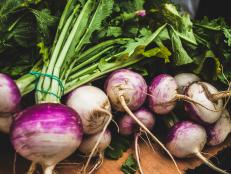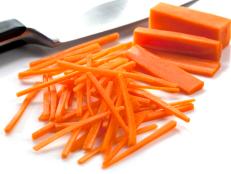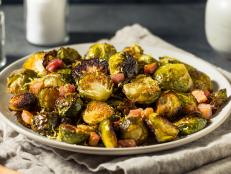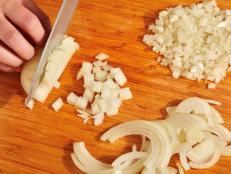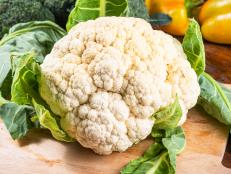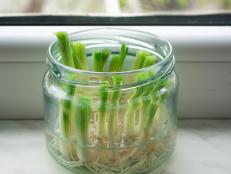What Is Taro?
How to buy, store, prep and cook with this tropical root vegetable.

Desti Marjanah/Getty Images

You might know taro as a key ingredient in Hawaiian poi or recognize the root vegetable as a staple of Caribbean, African or Southeast Asian cuisine. But what exactly is it? For more information, we consulted Jonathan Pasion, executive sous chef at Fairmont Kea Lani in Maui.

catinsyrup/Getty Images
What Is Taro?
Taro is a tropical root vegetable that has a brown, hairy exterior and purple-flecked, starchy flesh with a nutty, sweet flavor.
Taro was originally found in Southeast Asia, but today taro is also grown in and considered a staple ingredient Hawai’i and other Pacific islands, the Caribbean, Africa, Japan and the Philippines. “In Hawaii taro is best known for its use in poi, which is cooked taro then pounded into a paste and blended with water into a pudding-like consistency,” Pasion explains. “The poi is then often fermented, which gives it its sour flavor. Also, the starchy staple food paste is used for consumption in ceremonies and medicine, as well as local cuisine.”

Douglas Peebles
What Does Taro Taste Like?
Taro has a distinct mild, nutty flavor with a slightly sweet aftertaste. “Its flavor is often compared to a combination of potatoes and artichokes,” Pasion says. “The starchy nature of taro gives it a creamy and smooth texture when cooked, making it an excellent ingredient for soups, stews, and curries.” Taro leaves are also edible once properly cooked. Pasion says cooked taro leaves have “a mild nutty flavor and a texture similar to sweet potato.”

Dinusha Rajapaksha/Getty Images
Ube vs Taro: What’s the Difference?
Ube (also known as purple yam) and taro are both starchy root vegetables but they differ in appearance and taste. “Ube has a light brown, roughly textured outer layer with distinctive purple flesh. Taro, on the other hand, has a hairy outer layer and the inside is a pale creamy color,” Pasion explains. However, when steamed and mashed, taro takes on a purple hue, so cooked taro more closely resembles ube. Pasion says that ube is generally sweeter than taro and is often compared to having a vanilla flavor, making it well suited to sweet-leaning culinary applications. “Ube is more used as a flavor in pancakes, cakes, ice creams, bubble teas, drinks, donuts and more,” he says.

panida wijitpanya/Getty Images
How to Buy, Prep and Store Taro
How to Buy Taro
Head to a large grocery store or Latin American, Indian or East Asian market to find taro. When buying it, Pasion advises inspecting the outer root layer to ensure that it doesn’t contain mold, blemishes or soft patches and seeking out taro leaves that are pink or whiteish green in color with no holes or brown patches.
Types of Taro
In Hawaii, there are two main varieties of taro, so you’ll want to select the one that best suits your culinary needs. Upland taro is planted in non-flooded, rain-fed areas and is ideal for roasted dishes or as a potato substitution. Lowland taro is planted in waterlogged or flooded fields and is best suited for making poi.
How to Store Taro
Store taro in a dark, cool place and avoid storing taro in the refrigerator. Taro leaves can be placed in a perforated plastic bag and refrigerated. Cooked taro and taro leaves can be stored in the freezer in a freezer-safe container or bag.
How to Prep Taro
Taro cannot be consumed raw due to its high levels of calcium oxalate, a compound that causes kidney stones and mouth irritation, such as numbing, burning, and itching. To prepare taro, peel the outer layer under cool running water (or wear gloves or hold it with a dish towel) to protect your hands. Then, you can slice or chop the taro and boil, fry, bake or roast it.
Taro leaves are also edible but since they also contain toxic levels of calcium oxalate they must be cooked before consumption. To prepare taro leaves, Pasion recommends boiling the leaves. “Traditionally in Hawaiian [cuisine] taro leaves are used in luau stews or braised with aromatics and coconut milk.”

Kritchai Chaibangyang/Getty Images
How To Cook Taro
To cook with taro at home, treat it like you would potatoes or other starchy root vegetables. “When prepared properly, taro becomes melt-in-your-mouth tender, allowing it to soak up the flavors of the cooked dish,” Pasion says. “Its versatility in cooking methods, such as baking, boiling or frying, opens up many possibilities for using taro in various recipes.”
Slice taro into rounds and fry them to make potato chips, or slice it into strips to make this Seafood Bird’s Nest, a classic Chinese banquet dish which features taro strips that are molded and deep-fried to form a basket to hold a seafood-and-veggie stir-fry. You can batter taro and fashion them into appetizer-ready fritters, like these Southeast Asian-inspired crispy Fried Taro Bites. Make a taro puree by boiling peeled and chopped taro until tender, then processing it with butter and some of the cooking liquid until smooth. Or boil cubed taro just until tender, and then give it the potato treatment, either roasting it in the oven, tossing them into stir-fries or adding them to stews, soups or curries. Taro is also a prominent ingredient in taro sago, a traditional Chinese dessert soup, where it’s blended with coconut milk (and sometimes sweet potato). This Sweet Potato Tapioca Dessert Soup eschews the taro in favor of orange and purple sweet potatoes, but you can experiment by swapping some taro back in for a portion of the sweet potato.
What Is Taro Milk Tea?
Taro milk tea is a type of milk tea that is made with taro powder and often served with boba, chewy tapioca pearls. “Taro powder is a purple-colored powder that contains several ingredients. It has a sweet vanilla-like taste and is sweeter than taro itself. It releases a floral aroma,” Pasion says. “The starchy texture of taro powder helps to thicken beverages and desserts.”
Related Links:
























